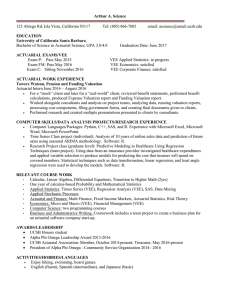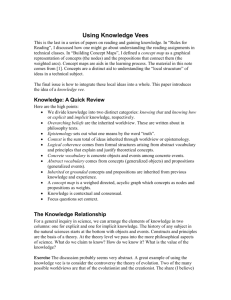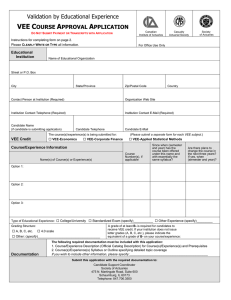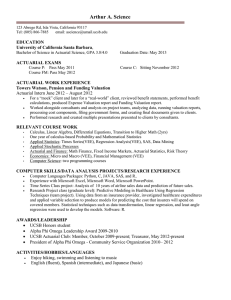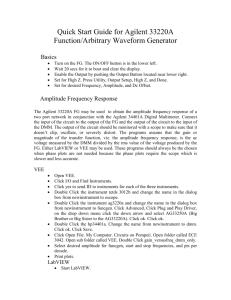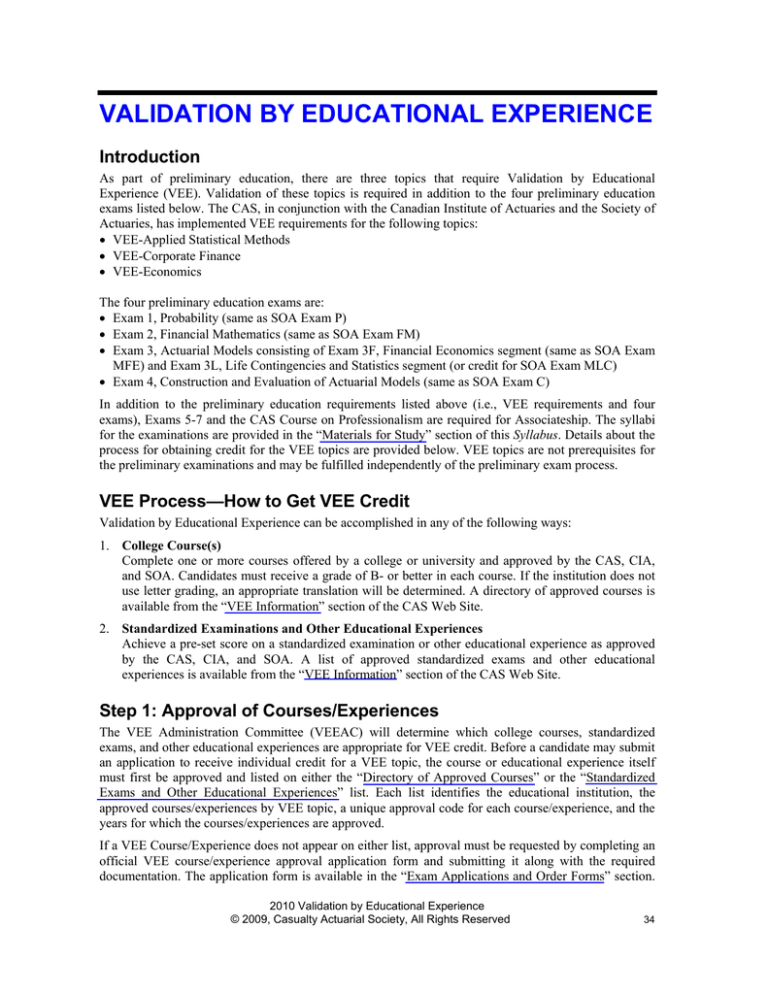
VALIDATION BY EDUCATIONAL EXPERIENCE
Introduction
As part of preliminary education, there are three topics that require Validation by Educational
Experience (VEE). Validation of these topics is required in addition to the four preliminary education
exams listed below. The CAS, in conjunction with the Canadian Institute of Actuaries and the Society of
Actuaries, has implemented VEE requirements for the following topics:
• VEE-Applied Statistical Methods
• VEE-Corporate Finance
• VEE-Economics
The four preliminary education exams are:
• Exam 1, Probability (same as SOA Exam P)
• Exam 2, Financial Mathematics (same as SOA Exam FM)
• Exam 3, Actuarial Models consisting of Exam 3F, Financial Economics segment (same as SOA Exam
MFE) and Exam 3L, Life Contingencies and Statistics segment (or credit for SOA Exam MLC)
• Exam 4, Construction and Evaluation of Actuarial Models (same as SOA Exam C)
In addition to the preliminary education requirements listed above (i.e., VEE requirements and four
exams), Exams 5-7 and the CAS Course on Professionalism are required for Associateship. The syllabi
for the examinations are provided in the “Materials for Study” section of this Syllabus. Details about the
process for obtaining credit for the VEE topics are provided below. VEE topics are not prerequisites for
the preliminary examinations and may be fulfilled independently of the preliminary exam process.
VEE Process—How to Get VEE Credit
Validation by Educational Experience can be accomplished in any of the following ways:
1. College Course(s)
Complete one or more courses offered by a college or university and approved by the CAS, CIA,
and SOA. Candidates must receive a grade of B- or better in each course. If the institution does not
use letter grading, an appropriate translation will be determined. A directory of approved courses is
available from the “VEE Information” section of the CAS Web Site.
2. Standardized Examinations and Other Educational Experiences
Achieve a pre-set score on a standardized examination or other educational experience as approved
by the CAS, CIA, and SOA. A list of approved standardized exams and other educational
experiences is available from the “VEE Information” section of the CAS Web Site.
Step 1: Approval of Courses/Experiences
The VEE Administration Committee (VEEAC) will determine which college courses, standardized
exams, and other educational experiences are appropriate for VEE credit. Before a candidate may submit
an application to receive individual credit for a VEE topic, the course or educational experience itself
must first be approved and listed on either the “Directory of Approved Courses” or the “Standardized
Exams and Other Educational Experiences” list. Each list identifies the educational institution, the
approved courses/experiences by VEE topic, a unique approval code for each course/experience, and the
years for which the courses/experiences are approved.
If a VEE Course/Experience does not appear on either list, approval must be requested by completing an
official VEE course/experience approval application form and submitting it along with the required
documentation. The application form is available in the “Exam Applications and Order Forms” section.
2010 Validation by Educational Experience
© 2009, Casualty Actuarial Society, All Rights Reserved
34
The VEEAC will review the course/experience.
The guidelines that the VEEAC will use to determine whether specific courses or educational
experiences are appropriate to fulfill the VEE requirements are provided in the next three sections of this
Syllabus.
Step 2: Approval of Individual VEE Credits for Candidates
Candidates who have credit for at least two actuarial examinations may submit an application for their
own VEE credits. In addition to the application, candidates will be required to arrange for an official
transcript to be submitted to the VEE administrator. The “Application for Validation by Educational
Experience Credit” includes specific directions. Only courses/experiences that are listed in the online
“Directory of Approved VEE Courses/Experiences” or the “Standardized Exams and Other Educational
Experiences” list may be used for VEE credit. If a course/experience is not on the approved list, the
candidate may submit the course for approval according to the procedures described in Step 1 above.
Candidates may combine two approved courses/experiences to complete a VEE topic requirement. For
example, an approved microeconomics course from a university may be combined with an approved
macroeconomics course from another school or provider. Likewise, an approved regression course may
be combined with an approved time series course from two different providers. In these cases candidates
should include approval codes from both approved courses on their individual VEE credit application
form. Corporate finance courses, however, must be completed in the combinations shown in the
directory. No alternate combinations will be accepted without an additional course approval
application process.
Note: Candidates may not submit VEE credit applications for partial credit (e.g., an approved regression
course may not be submitted alone, but must be accompanied on the same application by an approved
time series course). Candidates may not submit for VEE credit for a topic until they have completed all
requirements for that topic. Specific questions may be sent to vee@soa.org.
Once a candidate’s application and documentation of the required grade on an approved
course/experience have been validated, credit for the specific VEE topic will be granted. The candidate
will be sent a written response to each application.
2010 Validation by Educational Experience
35
VEE–Applied Statistical Methods
The following guidelines for the Validation by Educational Experience (VEE) requirement for Applied
Statistical Methods will be used by the VEE Administration Committee to determine whether specific
courses or educational experiences are appropriate to fulfill the VEE requirements. Details about
submitting a course for approval as well as obtaining individual VEE credit are provided at the beginning
of this section on VEE. The “Directory of Approved VEE Courses/Experiences” and the “Standardized
Exams and Other Educational Experiences” are available in the “VEE Information” section of the CAS
Web Site.
Courses that meet this requirement may be taught in the mathematics, statistics, or economics
department, or in the business school. In economics departments, this course may be called
Econometrics. The material could be covered in one course or two. The mathematical sophistication of
these courses will vary widely and all levels are intended to be acceptable. Some analysis of real data
should be included. Most of the topics listed below should be covered:
Regression analysis
1.
2.
3.
4.
5.
Least square estimates of parameters
Single linear regression
Multiple linear regression
Hypothesis testing and confidence intervals in linear regression models
Testing of models, data analysis, and appropriateness of models
Time series/forecasting
1.
2.
3.
4.
Linear time series models
Moving average, autoregressive, and/or ARIMA models
Estimation, data analysis, and forecasting with time series models
Forecast errors and confidence intervals
2010 Validation by Educational Experience
36
VEE–Corporate Finance
The following guidelines for the Validation by Educational Experience (VEE) requirement for Corporate
Finance will be used by the VEE Administration Committee to determine whether specific courses or
educational experiences are appropriate to fulfill the VEE requirements. Details about submitting a
course for approval as well as obtaining individual VEE credit are provided at the beginning of this
section on VEE. The “Directory of Approved VEE Courses/Experiences” and the “Standardized Exams
and Other Educational Experiences” are available in the “VEE Information” section of the CAS Web
Site.
The typical corporate finance program covers the topics below in two semesters with an introductory
course followed by a more advanced semester. If the second course covers most of the topics, then only
the second course will be required. Where the topics are split across two semesters or courses, both will
be required. The exceptional case where the corporate finance topics are covered in only one course,
with no finance prerequisite, will also be considered, however, this will typically be at a more advanced
level than a course designed for general business students.
Most of the topics listed below should be covered:
1. Definitions of key finance terms: stock company; capital structure
2. Key finance concepts: financing companies; characteristics and uses of financial instruments;
sources of capital; cost of capital; dividend policy; personal and corporate taxation
3. Factors to be considered by a company when deciding on its capital structure and dividend policy
4. Impact of financial leverage and long/short term financing policies on capital structure
5. Characteristics of the principal forms of financial instruments issued or used by companies, and the
ways in which they may be issued
6. How a company's cost of capital relates to the investment projects the company wishes to undertake
7. Definitions of key finance terms: financial instruments – bond, stock, basic options (calls, puts);
dividends; price to earnings ratio
8. Structure of a stock company and the different methods by which it may be financed
9. Calculate value of stocks
10. Measures of financial performance: balance sheet; income statement; statement of cash flows;
financial ratios (e.g., leverage, liquidity, profitability, market value ratios); net present value; the
payback, discounted payback models; internal rate of return and profitability index models
11. Assessment of financial performance using various measures: balance sheet; income statement;
statement of cash flows, financial ratios (e.g., leverage, liquidity, profitability, market value ratios);
net present value; the payback, discounted payback models; internal rate of return and profitability
index models
2010 Validation by Educational Experience
37
VEE–Economics
The following guidelines for the Validation by Educational Experience (VEE) requirement for
Economics will be used by the VEE Administration Committee to determine whether specific courses or
educational experiences are appropriate to fulfill the VEE requirements. Details about submitting a
course for approval as well as obtaining individual VEE credit are provided at the beginning of this
section on VEE. The “Directory of Approved VEE Courses/Experiences” and the “Standardized Exams
and Other Educational Experiences” are available in the “VEE Information” section of the CAS Web
Site.
Typically, the VEE requirement for Economics will be met if a candidate has completed two economics
courses, one course covering microeconomics and the other covering macroeconomics. Most of the
topics listed below should be covered:
Microeconomics
1. Interaction between supply and demand in the provision of a product and the way in which
equilibrium market prices are determined
2. Elasticity of demand and supply and the effects on a market of different levels of elasticity
3. How rational utility maximizing agents make consumption choices
4. How profit-maximizing firms make short-run and long-run production choices
5. Different types of competition, or lack of it, and the practical effect on supply and demand
Macroeconomics
1. Structure of public sector finances of an industrialized economy
2. GDP, GNP, and Net National Product. How these concepts are used in describing the economy and
in making comparisons between countries, and the limitations of these concepts
3. Propensity to save or to consume by the private sector or the corporate sector and how it affects the
economy
4. Impact of fiscal and monetary policy and other forms of government intervention on different
aspects of the economy, and in particular on financial markets
5. Role of exchange rates and international trade in the economy and the meaning of the term balance
of payments
6. Major factors affecting the rate of inflation, the level of interest rates, the exchange rate, the level of
unemployment, and the rate of economic growth in the economy of an industrialized country
2010 Validation by Educational Experience
38


